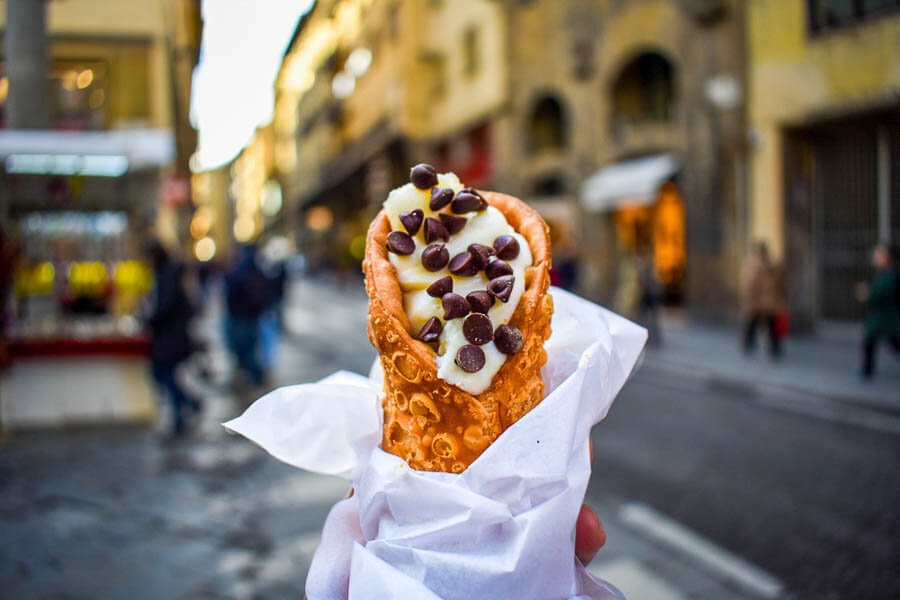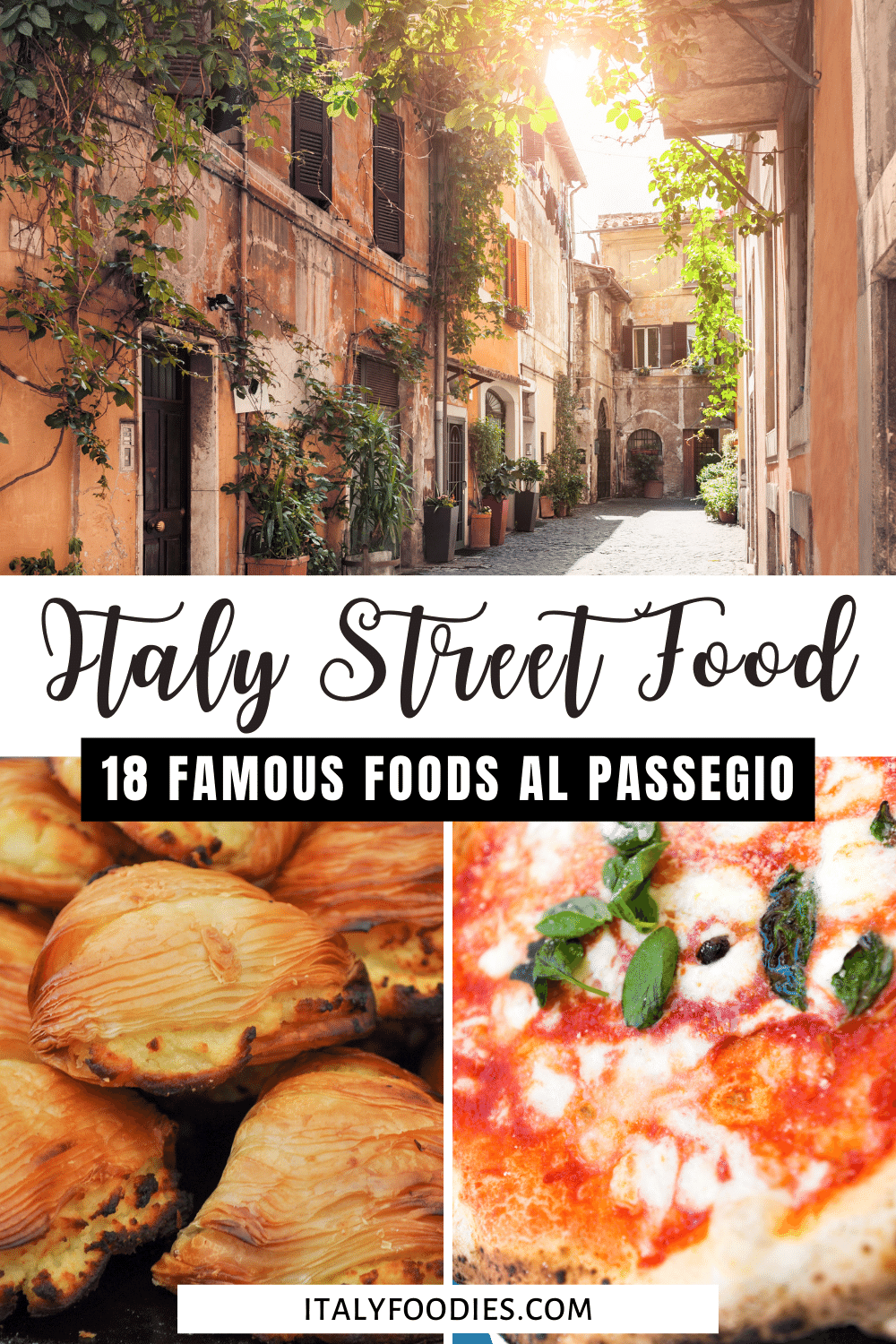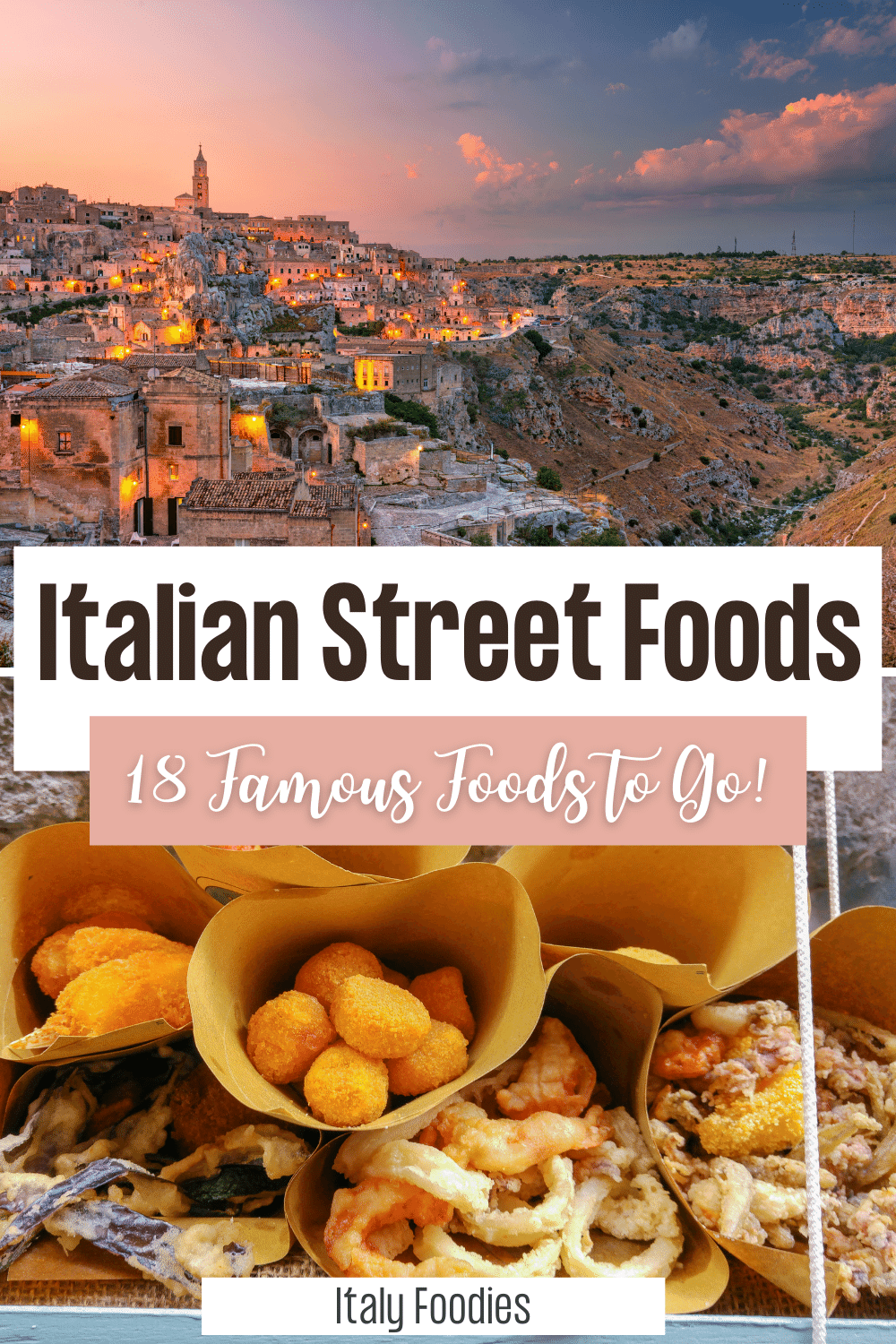Street Food in Italy: 19 Famous Foods to Eat On the Go
The key to understanding the history and culture of any country can usually be found in its cuisine, which is why eating the street food in Italy is one of favorite things to do. It’s the ultimate window into something deeper.
Some food travelers to Italy choose to try new restaurants which have well-deserved reputations for fine dining, but those in the know are aware that some of the most authentic and classic dishes can only be found on the streets.
Beyond the food itself, there are so many reasons to taste local street food on the go, or al passegio.
It’s a great way to support local Mom and Pop businesses, chat with the locals if they have time, and see a little more about how they prepare and construct the food you’re about to devour.
And of course, street food makes amazing photos when you add in the street itself for context.
Most Italy street food — and Italian food in general — will tell you about the economics, politics, agriculture, and climate of a place.
It can reveal the smallest, most subtle secrets as well. Like which village the maker’s family came from.
Cannolis are one of Italy’s most popular street foods
Italy Street Food Reveals More
For instance, I once had a cannoli in Italy that tasted delicious, but there was something unusual about the flavor of the cheese filling.
I had tasted many cannolis in my life by then and knew some of the subtle differences you might find.
Most Nonnas make their filling with ricotta cheese, the traditional way. But some tweak things a little and add mascarpone cheese.
Others add candied citron on the ends (traditional in Naples) and some add chocolate chips.
But this one was different, with a whiff of spice or cinnamon. Some fragrant scent lingered on my tongue.
When I asked the shopkeeper about the flavor (hoping he spoke a little English which he did), he told me of his family’s background — they were from Tunisia and emigrated to Sicily when he was a child.
Eating food on the street turns an ordinary travel moment into a slow travel experience.
And when it comes to street food, Italy has some unique treats you have to try to experience the rich and colorful Italian food scene that can’t be replicated anywhere else in the world.
Famous Street Food in Italy
1. Arancini
Origin: Sicily
The word Arancini literally means 'little oranges' but that is where any similarity ends since there is no hint of fruit in these amazing golden rice balls which originated in Sicily.
These deep fried rice dumplings, a pride of the rotisseries of Sicily, are now a popular street food found all over Italy.
The balls are usually stuffed with peas, cheese and minced meat and are served with hot arrabbiata sauce.
You’ll find them served as appetizers in local restaurants, in local markets throughout Italy, and street carts from one end of the boot to the other.
2. Sfogliatelle
Origin: Naples
This curious clam-shaped pastry is one of the most ubiquitous Campania foods, but don’t think for a second it has anything to do with seafood. This flaky confection is truly a sight to see being made if you get the chance.
In the end, the sweet ricotta cheese mixture inside pairs so well with the baked sweet dough, and together it is one of the most famous street foods in Naples.
As for the funny name, Napolitanos call it “svoo-ya-dell” and every street vendor will know what you mean!
Sfogliatelle was invented in Naples
3. Cioccolata Calda (Italian Hot Chocolate)
Origin: Spain
It you’re visiting Italy around the holidays or anytime when the weather turns cold — especially in northern Italy from the slopes to the cities — you’ll see thick and creamy Cioccolata calda, or Italian hot chocolate, being ladled into mugs and sometimes topped with a dollop of whipped cream.
Try it — especially if you love chocolate. It’s hard to describe how amazing and delicious this Italian drink is, but there’s no denying how comforting.
Once you try hot chocolate in Italy, you’ll never go back to buying powder again!
4. Porchetta
Origin: Ariccia, Rome
If there was ever a doubt that Rome is one of Italy’s best food cities, this traditional food is a fine example of country peasant food and popular Rome street food in one.
Porcetta is a traditional pork roast that can be found all over the streets of Italy, but especially in the central part of the country in the Province of Rome where it has its roots.
A fully-grown boneless pig or piglet is painstakingly stuffed with aromatic herbs or just salt and spices depending on which region of Italy it is being made.
After roasting the meat over a slow wood fire, the meat is cut into thin slices and served hot with a piece of bread.
Like the most tender roast pork sandwich you’ll ever have, this is one treat to look for in Rome.
5. Cannoli
Origin: Sicily
Cannoli are basically pastries that are filled with chocolate, cream or sweet ricotta and moulded in the shape of a tube.
Street vendors sprinkle these deep-fried rolls with powdered sugar to compliment the outside with the sweet savories inside.
Ask the vendor for more than one napkin as eating these delicious pastries can get very messy.
6. Gnocco Fritto
Origin: Bologna and Modena
Whether you call this favorite treat from Emilia Romagna crescentina, pizza fritta, torta fritta, piadina fritta, or gnocco fritto, it’s basically the same food that every Bolognese or Modenese loves, especially for breakfast.
These soft doughy pillows fry up in oil, leaving a hollow center that then becomes the perfect vessel to stuff in pieces of cured meat and cheese, with a touch of candied fruit relish for good measure.
It’s one of the most popular foods in Modena, served with and dunked in a hot frothy cappuccino for breakfast, but you’ll also find them served at restaurants, at street food stalls, and in every home throughout Emilia Romagna.
Gnocco fritto with a frothy cappuccino — Buongiorno, Modena!
7. Piadina Romagnola
Origin: Rimini
This Italian flatbread is griddled and eaten as a sandwich filled with cheese, tomatoes and some wild arugula.
Often made from maize flour, Piadina Romagnola at one time used to be the staple street food of the poorer part of the population.
Today this humble dish finds itself on the list of many traditional menus at numerous kiosks known as Piadinerie.
The sandwich is best enjoyed hot as soon as it is prepared on the griddle.
The most creative Piadina we’ve ever had in Parma was filled with ham, gorgonzola, grilled vegetables and figs — now that was a great food combo!
Arrosticini in Abruzzo is one of the most popular Italian street foods
8. Arrosticini
Origin: Abruzzo
This popular meat dish originated in the Abruzzo mountains and was the staple of shepherds who used the meat of the sheep and grilled it on a charcoal fire known as a fornacella.
Also referred to as rustelle the skewers today are made from the flesh of a castrated sheep, lamb or even goat.
Once cooked, the arrosticini is cut tenderly and mixed with big chunks of fat to make them more succulent.
If you find yourself in Abruzzo where English may not be widely spoken, and want to try the arrosticini at a local street food stand, listen to the people ahead of you for tips on how to order your food.
Sometimes you can buy just one skewer, but typically you’ll get a handful of 5 or 6.
9. Panzerotti
Origin: Puglia
An example of peasant cuisine of Puglia, this tasty street dish is basically a half moon shaped pastry made from soft leftover dough. The stuffing consists of tomato and cheese and fried till crisp from the outside and eaten hot.
While panzerotti can be made with some of the most common ingredients found in the kitchens of Italy, variations exist in some parts of the south where regional produce like anchovies, olives and scamorza cheese influences the recipe.
This street food favorite is found in pizzerias and local delis all over the country, especially southern Italy.
10. Scaccia
Origin: Ragusa
This Sicilian delicacy is unlike anything of its kind. Like other good street foods of Italy, scaccia also was a peasant staple till it found its way into Sicilian households.
This super-thin pizza dough is folded into a loaf resembling a lasagna, served in cut square shaped pieces, warm from the oven.
Scaccia is flavored with cheese, sauce, herbs and sometimes eggplant. No matter how it comes out of the oven, this lasagna bread dish will always have a great curb appeal.
Suppli fresh from the fryer!
11. Suppli
Origin: Rome
Perhaps the most famous street food in Rome, suppli is made with rice and cooked with a little tomato sauce. Sometimes even a little ground beef is added.
This classic Roman street food is another traditional peasant dish as the poor always found a way to use leftover rice from risotto.
Even though the first written record of suppli dates back to the 19th century, they soon became one of the city’s favorite snacks and remain popular even these days.
12. Sfincione
Origin: Sicily
This authentic Sicilian pizza recipe comes from the province around Palermo, the capital city of Sicily.
While Sfincione is found on the streets all year round, it is traditionally served during feast of San Giovanni and on New Year.
The crust is dense and fluffy and not dense with a crisp bottom layer.
The ingredients which go into making this mouth-watering Sicilian specialty dish are tomatoes, anchovies, oregano and cheese from the Sicilian sheep.
Zeppole are one of the most famous street foods in Italy
13. Zeppole
Origin: Naples
These deep fried dough balls have their roots in Naples, but today they are found on the shelf of most Italian bakeries in one form or another and at any street festival.
The delicious morsels of Zeppole are piped with custard, jelly, cream or even chocolate and sold on street corners. You might also find them unstuffed, and topped with mounds of powdered sugar.
This is the original and most traditional version — straight from the fryer, topped with sugar and tossed in a paper bag to glaze them. Delicioso!
14. Olive Ascolana
Origin: Le Marche
These meat stuffed and breaded fried olives are a speciality of Ascoli Piceno in the Le Marche region of central Italy.
Cooks of rich families used to utilize the leftover meat from the gala feasts and reformed them with a touch of nutmeg and cheese into this savory dish.
They are ideal for a snack washed down with wine or a starter till your pizza arrives.
If you want to try this delightful snack, the coastal areas of Le Marche are the best even though it is available on the sidewalks of Italy.
Vegans beware — Lampredotto is popular street food in Florence
15. Lampredotto
Origin: Florence
The abomasum, also known as the fourth and last stomach of a cow (that’s right, a cow has four!), is the main ingredient which goes into preparing this unique Florentine dish and the most famous street food in Florence.
You simply cannot miss Florence and the chioschi street food stands where you can buy this culinary tradition — a sandwich filled with lampredotto.
This edible cow organ meat will make any vegan wince, but it’s without a doubt a local favorite, and it’s hard to argue with the flavor.
Traditionally served on a crispy bun and soaked in green sauce. this simple sandwich will satisfy any carnivore.
Look for the piazzas and hidden corners throughout the city with the longest lines — that’s where you’ll find the best lampredotto in Florence.
16. Sgagliozze
Origin: Bari
This humble dish also known as fried polenta, is popularly sold after the mass in the St Nicholas Cathedral on the square of Bari.
Sgagliozze is dedicated to the saint and is a winter street food speciality of this region.
The polenta is fried in square or rectangular shape and walking the streets of Italy with a bag of hot sgagliozze is said to be a true culinary experience.
Brioche and gelato is one of Italy’s most famous street foods — a marriage made in Italy!
17. Gelato brioche
Origin: Sicily
The original ice cream sandwich probably has its origins in the popular Italian street food known as Gelato Brioche.
The famous treat is simply a sweet-dough brioche bun stuffed with a generous scoop or two of gelato, and together becomes a creamy concoction that steals the show when it comes to great Italian desserts.
This sweet sandwich, which is found throughout Italy is more or less a breakfast favorite, especially during the summer months.
As the ice cream melts in the sandwich it gets absorbed into the delicate texture of the brioche, melding together to make the perfect combination of soft, sweet, and textural — a marriage made in heaven!
It’s a popular delicacy in most gelato shops with regional variations of course. If you can, try it in Sicily where it all began.
18. Cuoppo Napoletano
Origin: Naples
As you stroll the streets of Naples, you may notice people holding paper cones filled with bite-sized foods.
This paper cup, or ‘Cuoppo’ is filled with an assortment of deep-fried snacks that can be bought on every street in Campania.
This ultimate street food includes bite sized pieces of mozzarella, dough balls, potato croquettes and other fried ingredients to make a perfect snack to enjoy on the go.
You’ll also find non-veggie variations stuffed with fish and meat fillings that are also worth a try.
19. Pizza al Taglio
Origin: Rome
Pizza al taglio first originated on the streets of Rome in the late 1950's and today finds itself at the top as the most loved street food all over Italy.
This Italian Pizza is typically baked in rectangular shaped trays and when ready it is cut in square or rectangular slices and is sold either per piece or by weight.
The pizza is light and can be digested easily on the go.
***
They say if you want to savor Italy, try the street food. We agree you should never deprive yourself of this small pleasure. After all, isn’t that the true nature of Italy? Italians are masters of the art of small pleasures.
And street food in Italy is just another example of this — stopping on the go for a well-deserved treat, or eating a meal al fresco made fresh while you wait.
One short walk through the streets of Italy will be enough to get you to try a tasty snack or two.
Italy street food has become not only an art but an excellent way of keeping the food traditions of the country alive, with even the best chefs inspired by authentic Italian street food dishes.










